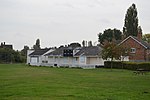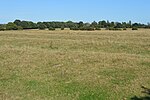Hartford, Cambridgeshire

Hartford is a suburb of Huntingdon and former civil parish, now in the parish of Huntingdon, in Cambridgeshire, England. Historically part of Huntingdonshire, it is not far west of Wyton. It lies on the A141 road and on the north bank of the River Great Ouse, upon which it has a significant marina. The village is not to be confused with the much larger town of Hertford, some 38 miles (61 km) to the south-east. In 1931 the parish had a population of 464. On 1 April 1935 the parish was abolished and merged with Huntingdon, part also went to Houghton and Wyton and Kings Ripton.It is sometimes known as Hartford-cum-Sapley, and in the past has been known as Hereford by Huntingdon, Herford, Hertford and Harford. All Saints' Church in Hartford is a Church of England parish church, built in 1180 on the north riverbank. It is a Grade II* listed building. The church has six bells.
Excerpt from the Wikipedia article Hartford, Cambridgeshire (License: CC BY-SA 3.0, Authors, Images).Hartford, Cambridgeshire
Falcon Drive, Huntingdonshire Oxmoor
Geographical coordinates (GPS) Address Nearby Places Show on map
Geographical coordinates (GPS)
| Latitude | Longitude |
|---|---|
| N 52.341 ° | E -0.158 ° |
Address
Falcon Drive
Falcon Drive
PE29 1LP Huntingdonshire, Oxmoor
England, United Kingdom
Open on Google Maps








